
Gelisols are an order in USDA soil taxonomy. They are soils of very cold climates which are defined as containing permafrost within two meters of the soil surface. The word "Gelisol" comes from the Latin gelare meaning "to freeze", a reference to the process of cryoturbation that occurs from the alternating thawing and freezing characteristic of Gelisols.

The World Reference Base for Soil Resources (WRB) is an international soil classification system for naming soils and creating legends for soil maps. The currently valid version is the fourth edition 2022. It is edited by a working group of the International Union of Soil Sciences (IUSS).
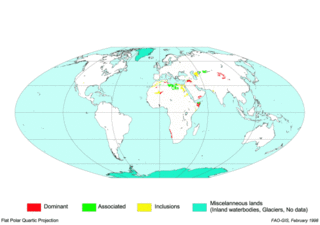
Gypsisols in the World Reference Base for Soil Resources (WRB) are soils with substantial secondary accumulation of gypsum (CaSO4.2H2O). They are found in the driest parts of the arid climate zone. In the USDA soil taxonomy they are classified as Gypsids (USDA Soil Taxonomy), in the Russian soil classification they are called Desert soils (USSR).

An Acrisol is a Reference Soil Group of the World Reference Base for Soil Resources (WRB). It has a clay-rich subsoil and is associated with humid, tropical climates, such as those found in Brazil, and often supports forested areas. In the USDA soil taxonomy, Acrisols correspond to the Humult, Udult and Ustult suborders of the Ultisols and also to Oxisols with a kandic horizon and to some Alfisols. The Acrisols low fertility and toxic amounts of aluminium pose limitations to its agricultural use, favouring in many places its use for silviculture, low intensity pasture and protected areas. Crops that can be successfully cultivated, if climate allows, include tea, rubber tree, oil palm, coffee and sugar cane.
Solonetz is a Reference Soil Group of the World Reference Base for Soil Resources (WRB). They have, within the upper 100 cm of the soil profile, a so-called "natric horizon". There is a subsurface horizon (subsoil), higher in clay content than the upper horizon, that has more than 15% exchangeable sodium. The name is based on the Russian соль. The Ukrainian folk word "solontsi" means salty soil. In Ukraine, many villages are called Solontsі.

A gleysol or gley soil is a hydric soil that unless drained is saturated with groundwater for long enough to develop a characteristic gleyic colour pattern. The pattern is essentially made up of reddish, brownish, or yellowish colours at surfaces of soil particles and/or in the upper soil horizons mixed with greyish/blueish colours inside the peds and/or deeper in the soil. Gleysols are also known as Gleyzems, meadow soils, Aqu-suborders of Entisols, Inceptisols and Mollisols, or as groundwater soils and hydro-morphic soils.
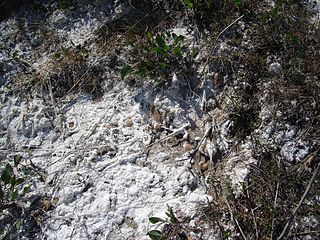
Solonchak is a Reference Soil Group of the World Reference Base for Soil Resources (WRB). It is a pale or grey soil type found in arid to subhumid poorly-drained conditions. The word is Russian for "salt marsh", which is in turn from the Russian sol (соль) "salt". The Ukrainian folk word "солончак", which in turn from Ukrainian "salty" (солоний) + "чак"—suffix; designation of an object that has the property. A village with the name Solonchaky exists in Ukraine.

Lixisols are a Reference Soil Group of the World Reference Base for Soil Resources (WRB). They are soils with subsurface accumulation of low activity clays and high base saturation. They develop under intensive tropical weathering conditions and subhumid to semi-arid climate.

A Leptosol in the World Reference Base for Soil Resources (WRB) is a very shallow soil over continuous rock or a deeper soil that is extremely rich in coarse fragments. Leptosols cover approximately 1.7 billion hectares of the Earth's surface. They are found from the tropics to the cold polar regions and from sea level to the highest peaks. Leptosols are particularly widespread in mountain areas, notably in Asia, South America, northern Canada and Alaska; and in the Saharan and Arabian deserts. Elsewhere, Leptosols can be found on hard rocks or where erosion has kept pace with soil formation or removed the top of the soil. In the FAO soil classification for the FAO/UNESCO Soil Map of the World (1974) the Leptosols on calcareous rock were called Rendzinas, those on acid rock were Rankers. The very shallow, less than 10 cm deep, Lithic Leptosols in mountain regions are the most extensive Leptosols on Earth.
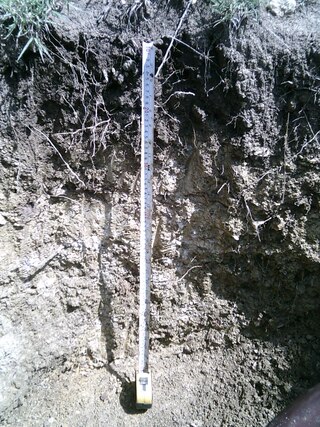
A Cambisol in the World Reference Base for Soil Resources (WRB) is a soil in the beginning of soil formation. The horizon differentiation is weak. This is evident from weak, mostly brownish discolouration and/or structure formation in the soil profile.

A Durisol is a Reference Soil Group under the World Reference Base for Soil Resources (WRB) referring to free-draining soils in arid and semi-arid environments that contain grains cemented together by secondary silica (SiO2) in the upper metre of soil, occurring either as concretions (durinodes – duric horizon) or as a continuously cemented layer (duripan – hardpan (Australia) – dorbank (South Africa) – petroduric horizon). The name is derived from Latin durus for hard.
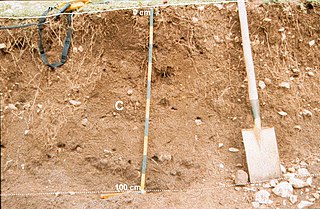
A Regosol in the World Reference Base for Soil Resources (WRB) is very weakly developed mineral soil in unconsolidated materials. Regosols are extensive in eroding lands, in particular in arid and semi-arid areas and in mountain regions. Internationally, Regosols correlate with soil taxa that are marked by incipient soil formation such as Entisols in the USDA soil taxonomy or Rudosols and possibly some Tenosols in the Australian Soil Classification.
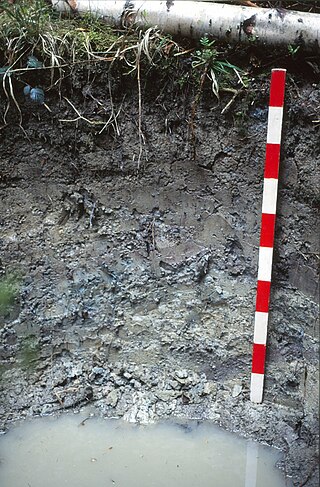
A Stagnosol in the World Reference Base for Soil Resources (WRB) is soil with strong mottling of the soil profile due to redox processes caused by stagnating surface water.
A Technosol in the World Reference Base for Soil Resources is a Reference Soil Group that combines soils whose properties and pedogenesis are dominated by their technical origin. They contain either a significant amount of artefacts, some sort of geotechnical liner, or are sealed by technic hard material. They include soils from wastes, pavements with their underlying unconsolidated materials, soils with geomembranes and constructed soils in human-made materials. Transported natural soil material does not qualify as Technosol and is described with the Transportic qualifier in WRB. Technosols are often referred to as urban or mine soils. They are recognized in the new Russian soil classification system as Technogenic Superficial Formations.
An Alisol is a Reference Soil Group of the World Reference Base for Soil Resources (WRB).
An anthrosol in the World Reference Base for Soil Resources (WRB) is a type of soil that has been formed or heavily modified due to long-term human activity, such as from irrigation, addition of organic waste or wet-field cultivation used to create paddy fields.
Luvisols are a group of soils, comprising one of the 32 Reference Soil Groups in the international system of soil classification, the World Reference Base for Soil Resources (WRB). They are widespread, especially in temperate climates, and are generally fertile. Luvisols are widely used for agriculture.
Plinthosols are iron-rich soils characterized by the presence of plinthite, petroplinthite or pisoliths.

Nitisol, in the World Reference Base for Soil Resources (WRB), is a deep, red, well-drained soil with a clay content of at least 30% and a polyhedral structure or a blocky structure, breaking into a polyhedral or a flat-edged structure. The soil aggregates show pressure faces. Nitisols correlate with the kandic alfisols, ultisols and inceptisols of the USDA soil taxonomy.

A Phaeozem in the World Reference Base for Soil Resources (WRB) is a dark soil with a high base status, but without a secondary carbonates within one metre of the soil surface. Most Phaeozems correlate with the Udolls (Mollisols) of the USDA soil taxonomy.













